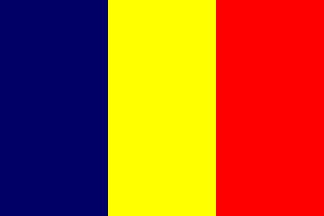
![[National flag]](../misc/oooxxx.gif) 2:3
2:3
by Zeljko Heimer
Flag adopted 6 November 1959, coat of arms adopted 11 August 1970.

Last modified: 2004-12-29 by zeljko heimer
Keywords: chad | africa | pan-african | spain | france | libya | central african republic | ethiopia | uganda | sky | hope | agriculture | desert | prosperity | unity |
Links: FOTW homepage |
search |
disclaimer and copyright |
write us |
mirrors

![[National flag]](../misc/oooxxx.gif) 2:3
2:3
by Zeljko Heimer
Flag adopted 6 November 1959, coat of arms adopted 11 August 1970.
Vertical tricolour of blue-yellow-red.
The French Navy flag book L'Album, 2000 [pay00] gives this colour approximation for the Chad flag:
blue Pantone 281c - CMYK 100-70-0-35
yellow Pantone 116c - CMYK 0-10-95-0
red Pantone 186c - CMYK 0-90-80-5
This gives blue slightly darker then that given for Romania (both are approximations
made by Armand du Payrat, the editor of the Album, based on flag reported in use).
Zeljko Heimer, 29 March 2003
The blue-yellow-red colours of Chad are a combination of the blue-white-red of France, the former colonial power, and the green-yellow-red of the Pan-African (e.g., Ethiopian) ones. Cf. Central African Republic whose colors are blue-yellow-red and green.
Similarly Andorra's blue-yellow-red is a combination of the national colours of France and Spain. Accidentally, the flag is the same as the flag of Romania.
Roy Stilling, 10 October 1995
The flag of Chad was adopted by law # 59/13 on 11 June 1959 (that is more than one year before independence). Source: Vagnat & Poels, 2000 [vap00],
Smith, 1976 [smi76]
Ivan Sache, 11 April 2003
Full name: Republic of Tchad (République du Tchad).
Location: Central Africa.
Status: Independent Republic.
Chad is the fifth largest country in Africa (1,284,000 sq. km; 1,700 km from north to south; 1,000 km from east to west).
The country is located in Central Africa and bordered by Libya (north), Central African Republic (south), Sudan (east),
and Niger, Nigeria and Cameroon (west).
In 1997, the population of Chad was estimated 7,166,000 (density 5.6 per sq. km).
According to the 1993 census, only one fifth of the Chadians live in urban areas, the most important cities
being N'Djamena (the capital city, formerly known as Fort-Lamy, 530,000), Moundou (280,000), and Bongor (200,000).
The ethnolinguistic composition of the population is very diverse. The three most important groups represent only
50% of the total population: Sara (27.7%), Sudanese Arabs (12.3%), and Mayo-Kebbi (11.5%). Muslims are slightly
dominant (54%), whereas 35% of the Chadians are Christians. The official languages are French and Arabic and
there is no official religion.
Ivan Sache, 11 April 2003, based on Presentation of Chad & Encyclopaedia Universalis Yearbook
A short history:
A bit longer history:
The first inhabitant of Chad whose remained have been preserved is Abel, discovered in January 1995
by the French paleontologist Michel Brunet. Abel even predates the famous Lucy, found in Ethiopia.
Lucy's "father" Yves Coppens admitted that the centre of early appearance of modern humans must now
be considered to be Chad. Rock paintings and engravings found in the Tibesti and the Ennedi demonstrate
a more recent but still very ancient populating of the area. Chad has been for centuries a contact zone
between the Arabs from Northern Africa and the inhabitants of subSaharan Africa. Therefore, the history of
Chad is characterized by ethnical and religious disputes which are not solved yet. Chad was not only a
crossroad of transSaharan commercial trails, but had also its own wealth, mainly salt and copper mines.
The oldest known kingdom in Chad was found in Kanem by the Sefawad dynasty in the XIth century. Around 1100,
the rulers ("mai") were converted to Islam, which spread all over the area. The kingdom had a big army, a
powerful administration and a flourishing economy. However, internecine quarrels and religious dissenssions
undermined the Sefawad power. The Boulala, vassals of Kenam, revolted. In the XIVth century, the Sefawad
fled from Kanem because of repeated attacks by Arab tribes. The Sefawad restored their power in Bornou,
west of lake Chad, in the XVth century. Mai Idris (1497-1519) invaded Kanem and incorporated it to his
kingdom, which stretched from Kano (now in Nigeria) to Darfour. Other kingdoms were founded in the area,
namely Ouaddai (XIVth century) and Baghirmi (XVIth century), which were vassals of Kanem-Bornou. The main resource
of this kingdom was slave trade with Arabia, which motivated conquest wars.
In the middle of the XIXth century, the Fulani ruler Ousman dan Fodio founded the Caliphate of Sokoto (now in Nigeria)
and called for jihad. Fodio attacked the kingdom of Kanem-bornou but was repelled by Prime Minister Muhamad Amin al-Kanemi.
The Prime Minister modernized the monarchy and confiscated the power, which he transmitted to his son Umar.
He built a new capital city, Kouka (now in Niger). During the troubles, Ouaddai regained its autonomy and
annexated Baghirmi. At the same time, the Sinussi confrery became very popular in the area. In 1860, all these
rival kingdoms had fallen into decline. In 1879, Rabah, a slave merchant from Sudan, conquered Ouaddai. He ruled
over the east of Chad and maintained an army of 35,000. Commerce of ivory and slaves allowed him to buy modern
guns and ammunition and to found a vast empire.
In the middle of XIXth century, European explorers such as Heinrich Barth, Clapperton and Nachtigal visited central
Sudan. In 1891, Monteil reached lake Chad from Senegal. France then decided to conquer Chad in order to connect
its other possessions in Africa. On the pretext that Rabah was an esclvagist, France sent three missions from
Algeria, Niger and Congo in order to get rid of him. The three missions joined near the lake Chad in 1899, and
Rabah was defeated and killed in Kousseri in 1900. Rabah's empire disappeared but the Senussi resisted the
French "pacification" until 1917. In 1900, a Decree created the "Territoire militaire de